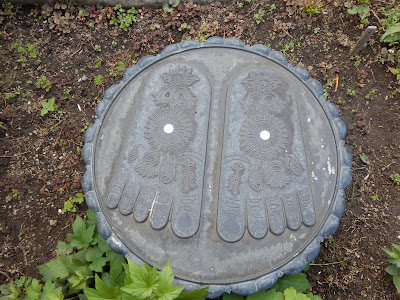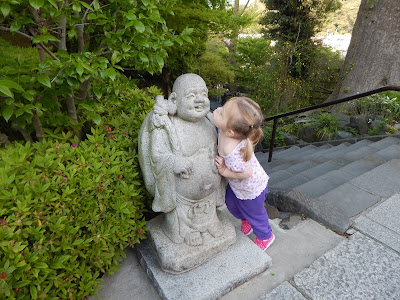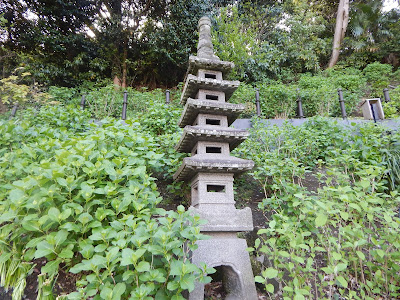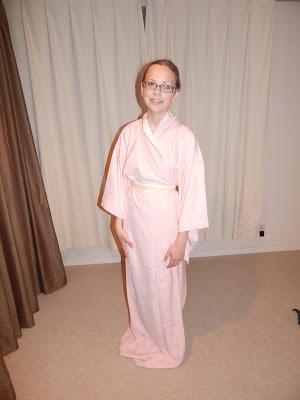We walked everywhere we went in Kamakura. We met a very nice gentleman at the metro station who runs a rickshaw for a living and gave Nathan a map of the city, which helped us get our bearings and figure out where to go. Nathan was very excited about his map and held onto it all day long. We enjoyed exploring the streets of Kamakura as we made our way to our first stop.
The wisteria is beginning to bloom. So pretty.
The streets in this town are also very narrow. This is a two way street. The Excursion would never make it here!
We climbed to the top of this hill to find....
....the Zeniarai Benten Shrine! Zeniarai Benten is unusual in that it is completely surrounded by high shear rock walls making it completely invisible from the outside. It can only be reached by going through a tunnel which has been carved by hand into the rock wall.
Once we came out of the tunnel and washed to purify ourselves, there was much to explore.
There were many smaller shrines surrounded by ponds full of koi fish and beautiful lanterns.
We climbed these stairs to find a shrine at the top.
Smelling the incense...
Eventually, we made our way over to the main shrine, which is why we came here. This shrine is in a cave. It was founded in 1185 by Minamoto Yoritomo, the first shogun of the Kamakura government.
According to legend, Yoritomo received a vision in a dream. In the vision, the messenger said, “In a valley to the north-west, there is a magical spring which spills forth from inside a cave. Go there and worship the kami (god) and we will bring peace to your people. ” Yoritomo traveled to the spring inside the cave and built a shrine here.
Ropes of paper cranes were hanging from the cave's ceiling.
It has long been believed that the water here has the power to multiply any money it comes in contact with. It is said that the money washed here will double in value. This tradition began in 1257 when Hojo Tokiyori, the fifth regent of the Kamakura government, came here and washed his coins in the spring's water. More for fun than greed, many people come here specifically to wash their money in the spring using the baskets and ladles provided. We were no exception.
I gave each of the kids some coins and they washed them in the sacred water. Each of the kids will keep their coins as a memento of this day. As for me, I wasn't washing coins, no sir. I brought out the big guns--paper bills! This is the equivalent of $300 USD, and I washed it in the sacred water, hoping for it to double in my wallet once it dried.
Logan was very intrigued by all the paper cranes that surrounded the water in this cave.
After we put our newly washed and clean coins and paper bills in a safe place, we began to walk to our next stop. Along the way, we met the rickshaw driver who gave Nathan his map at the metro station. He was taking his customers to the Zeniarai Benten Shrine. We smiled and waved and continued on our way.We soon arrived at the Daibutsu!!! This is the thing we were all the most excited to see today!! Here we are at the gate!
HOLY MOLY! There it is!!
Can't believe that we actually were able to see the actual Daibutsu--the infamous Great Buddha!!
The girls have learned about this great work in school and were so excited to see it and tell their siblings about it and why it is so famous.
The Daibutsu was cast in the year 1252, and the statue was originally housed in a wooden temple, but it was destroyed by a typhoon in 1335. During this storm, about 500 samurai went into the building to seek refuge from the storm, and when the temple collapsed they were all crushed. The temple was rebuilt, and in 1495 it was destroyed by an earthquake and a tsunami wave. Since then, the statue has sat outdoors unprotected from the elements. Tsunamis have reached this statue several times since and the area always received heavy damage. The Great Buddha, however, has always weathered through and stood strong through the centuries.
The Great Buddha of Kamakura is of the Amida Buddha. It is made of bronze and it the second tallest Buddha statue in Japan. One of the unique aspects of this Buddha is how the hands are shaped. Hand positions making circles with the thumb and index fingers of both hands is one of the typical patterns in Amida Nyorai statues in Japan and it is called "jo-bon jo-sho-in". The Kamakura Buddha has two small thumb position differences that make it unique, however. First, Daibutsu’s thumbnails are not angled upward. Second, Daibutsu’s thumbs are in front of (and hide) the tips of the forefingers. These small details make the Kamakura Daibutsu different from other Buddha statues in Japan. Some specialists say that this statue is of higher artistic value than that of any other Daibutsu, indicating its excellent balance, powerfulness, intelligence and dignity.
Standing next to one of the world's greatest works of art! SO FANTASTIC!!
For a mere 20 yen a piece--that's right, the equivalent of 20 cents--we could go inside the Great Buddha. We climbed up some narrow stairs and found ourselves inside this world treasure.
At one time, this statue fell into disrepair and gamblers and homeless people lived inside of it. Around the year 1712, a Buddhist priest in Tokyo decided to try to save the statue and was able to restore its former glory. Because of his efforts, the world can still enjoy this statue today.
In 1923, the statue’s base was damaged in the Great Kanto Earthquake and subsequently repaired. In 1960, the statue’s neck and its base were reinforced to help it survive future quakes.
You can notice several slight horizontal lines. This tells experts that it was a patchwork made with eight pieces of bronze. Even today's technology, however, can not figure out precisely how it was cast and built. When the statue was brand-new it had a quite different appearance from what we see today. It was gilt all over and should have been glittering. As time went on, the gilt came off, and today we can recognize its traces of the original coloring only in its ears.
Kirstin touching the inside of the Great Buddha.
At several places inside, we noticed what looked like Japanese writing and signatures of people written in English. At one time, people wrote their names inside the statue to show that they had been here. Can you see the Japanese and English writing in this picture?Along the back of the statue were these bronze markers. Each of them contained a lot of Japanese writing. Wish we knew what they said.
Behind the Daibutsu, there was a large courtyard containing gravel and trees and this lone statue.
Near the bathrooms, we found this marker: Daibutsu Temple Founded in A.D. 737. That was a really, really long time ago!
Looking at the Great Buddha from the back....
We were so stoked that we were able to see the Great Buddha in person, and it was hard to leave. But, we had to move on or our last stop would close before we were able to see it. If you look close, you can see the head of the Great Buddha through the trees.
Along the way to our last stop for the day, Caitlin found a kimono shop and was able to purchase a kimono that she liked.
Here we are at the gate for the Hase Dera Temple. I thought the scenery at this gate was so pretty...little did we know that the entire temple would be simply gorgeous.
When we went inside, we saw a beautiful scene of Japanese landscape.
Love the manholes around here!
Gorgeous....
....gorgeous!!
Found this cute trio in some of the greenery.
Along the steps to the main temple are rows of small statues of Jizo, the guardian deity of children. Historically, parents came to Hasedera to set up these statues in hopes the deity would protect and watch over their children.Today, though, the Jizo statues represent the souls of miscarried, stillborn or aborted children. Some of the statues are dressed in bibs, hand-knitted caps and sweaters. More than 50,000 Jizo statues have been offered here since the war, but the thousand or so currently displayed will remain only a year before being burned or buried to make way for others.
As we neared the temple, we saw this statue and Audra loved him--probably because he was the same size as she is. She gave him a kiss.
The path through the two buildings led to a cemetery.
The architecture of the Hase Dera Temple was impressive. So pretty, with bronze bells at the corners.
Inside the Hase Dera Temple sits a Kannon statue with an interesting legend.
In the 8th century, a monk was walking through a forest and found a huge tree. He arranged to have not one, but two Kannon statues made from this tree. One of the images was kept in a temple in Hase, near Nara, while the other was cast in the sea to decide for itself where it should be worshipped.The image drifted for 300 miles before washing up on shore. But its first stop was evidently not the chosen place, as it brought bad luck or illness to everyone who touched it. The people in the village threw it back into the sea, and it eventually reached the shores of Kamakura. Here there were no ill effects, so the Hase Dera Temple (named for the statue's "birthplace") was built to give it a permanent home.
At more than 30 feet tall, this Kannon statue is the tallest wooden image in Japan. We could not take pictures inside of the temple, but it was an impressive image, especially knowing that it had once been in the ocean for a period of time.
The outside of the temple that houses the Kannon statue.
Just past the temple, there is a path that one can explore that will take you to the top of a hill overlooking the city. We decided to explore it.About halfway to the top, we were able to see the beach where the Kannon statue was found.
I just think these guys are so cute! Haven't seen these particular statues anywhere else, I wonder if they are just at this temple for a reason?
A stone pagoda along the pathway....
Finally, we reached the top....
....and could enjoy the views of Kamakura and the ocean spread out below us. Kamakura was once the headquarters for Yoritomo {yoh-re-toh-moh} Minamoto, the most notable samurai warrior as the founder of the Kamakura Shogunate and the military dictator of Japan. When he was rising to power, he used Kamakura as his headquarters because it was a natural fortress. There are hills on three sides and the ocean on the forth side, which can be easily seen in this view from the top of one of the hills.
On our way down, there were some gardeners who were cutting the dead blooms from the tulips and daffodils. They formed the stalks into these bundles to dry. I thought this was genius! I have always hated the dried, ugly stems in my yard from spring blooms. From now on, I'm going to copy the Japanese way of dealing with the stems of spring flowers and put them into bundles to dry!
Statues surrounded by wild irises.
We got to the bottom and walked around exploring the gorgeous gardens some more.
I love the bells that are often at the corner of the buildings. When the breeze comes, they make a soft and hollow sound that is calming.In one pond, we found tadpoles. These tadpoles were different from the ones we had seen at Shinjuku Gardens a week or so ago. These guys had their legs, but hadn't lost their tails yet.
This place is stunningly gorgeous!!
We went back through the temple area, past the thousands of Jozi statues, and down the stairs to the first garden that we saw.
Inside, we found a pathway through the cave. Carved into the walls were many statues.
The cave, called Benten Kutsu Cave, contains various statues and devotionals to Benzaiten, the sea goddess and the only female of the Seven Lucky Gods in Japanese mythology.
There were low tunnels that connected many different rooms in the cave.
We found thousands of these little statues all over the place. Some were even sitting in the depressions that made up the rock walls.
As we were exploring the cave, a security guard came in and told us that the temple grounds were closing. Time to go.
As we walked along the path that would take us to the exit, we found another cute statue.
Hase Dera was much more than we thought it was going to be! We found the grounds to be simply breathtaking and we didn't know about the cave full of Benzaiten statues prior to coming here. It was sad to leave such interesting and stunning surroundings, but the security guards were following us to make sure that we went out the exit and didn't wander off. It was only 4:30 p.m., so we decided to go down to the beach before heading back to Tokyo.
There were tons of surfers out catching waves.
The kids on the beach at Kamakura.
The beach was full of junk and trash...not very appealing to the eye. However,....
....there were lots of shells! Big ones, too! The kids quickly filled up two grocery bags full of shells before we made our way back to the metro to head home.At the metro station, I purchased a box of Kamakura's famous bird cookies. We ate them when we got home. They were bland. We were not impressed and are not sure why these cookies are something that Kamakura is known for.
Here is Caitlin in her kimono that she found just outside of the famous Great Buddha. It's a used kimono so she was able to get it for cheap. It's a little long, but that's easily fixed.
We did her hair up pretty to match her kimono.
Today was a FANTASTIC day! We found Kamakura to be a lovely place with so much to offer! I wish we could go back to explore more, but I don't think we will have the time before we have to leave.
Here's what the kids thought:Caitlin: I thought washing our money was kind of stupid. I really didn't see the point. The Great Buddha was cool, mostly because I learned about it at school and then I got to see it in real life. My art teacher would have freaked out. I didn't know that we could go inside of it, so that was neat. I got my kimono and I'm excited about it, especially since I got it for cheap. The views at Hase-dera Temple were really quite breathtaking, but the Buddhas that you could purchase and have displayed there were super expensive. A smaller one was $100 and a slightly bigger one was $200. Then, we went to the beach and I've never seen so many big shells all in one place. But, the beach was filthy. When the tide started coming in, some of the surfers' shoes started floating away. They weren't going to get their shoes back, it was kind of funny. There was a really pretty sunset. So, yeah, Kamakura was a good day. Dad should get a job in Tokyo so we can live in Kamakura and he can commute every day.
Tayla: I really liked the shrine where we washed our money. I thought it was really fun, but my money still hasn't doubled. The landscape there was really pretty and the cave was awesome. The Great Buddha was magnificent! It was really cool to be there and it was awesome to go inside of it! I really liked it there! At Hase-dera Temple, I really liked the view of Kamakura and the ocean. The gardens there were really, really pretty and all the tiny statues were cool. I especially liked the teeny tiny ones that were lit up in the cave. I liked looking for shells at the beach. I really liked finding the big spiral ones and some barnacles and all of the other shells that we found.
Christopher: The place where we washed our money was really cool. It was glorious. Hase-dera was really pretty and the cave where we saw all mini statues and the carvings in the rock was magnificient. The view from Hase-dera was fantastic. Finding shells was really fun. I enjoyed washing shells when we got home and finding shells inside of shells, like a shark's eye shell inside of a bigger shell. The Great Buddha was really awesome! It was everything good!
Logan: Washing our money was really fun. The cave was a lot shorter than I thought it was going to be. Being inside the Great Buddha was cool. It was neat to look at the structure and see the different pieces and how they put it together. Hase-dera was really pretty and the view of the city was cool. The view of the beach was interesting to see how it went in a half circle. In the cave, there was a carving of a girl with a banjo. It was neat. I thought the three statues with their hands together were cute. Collecting shells was fun and it was fun running out, grabbing a shell, and then quickly running back without getting wet from the waves was fun.
Nathan: Well, I got a map from a guy at the metro. He gave it to me for a souvenir. I was afraid I would loose my map in the gutter that was next to the street. Someone could accidentally drop it into the water in the gutter and it would be gone forever. Washing the money was fun, but it was complicated. Whoever thought of the idea to wash the money in this cave, it was a good idea! I washed my money, and then I washed it again because I loved washing my money. I wanted to wash it again, but it was time to go. Mom washed bills, not coins. The incense was really smoky there. When we got to the Great Buddha, I thought, "Why is this a great statue?" But then, I found out that we could go inside. His hair was funny because it was made of dots and he had another dot that was on his head and was almost touching his nose. I thought he had earrings. His hands were put together. When I got inside of the Buddha, I looked up inside the head. You could see the dots that were his hair. It was really cool to see the pieces that they used. Me and Audra were playing a game that we were eaten by a monster and we were inside his tummy. When we got to the temple where we could see all the statues, the view of the city was really nice. The tadpoles had feet. I kept finding ones with feet. They will turn into frogs. The cave that we went inside of, the ones with all the Buddhas, was awesome. The beach had a lot of waves. When we walked on the wet sand, we had to be watching the waves all the time to make sure that it didn't get you. We found a whole bunch of shells, but the others found a whole bunch of spiral shells. The chicken cookies were yummy, but they weren't real chickens.
Audra: I went inside a big statue. It was really cool. It was perfect. I want the pretty ones (shells) with flowers on it. Caitlin's 'mono (kimono) is pink.





















































































No comments:
Post a Comment